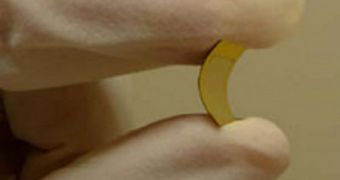Georgia Institute of Technology (Georgia Tech) experts announce the development of a new type of nanoscale generators, which are capable of producing sufficient amounts of electricity to power up small electronic devices, including liquid crystal displays and light-emitting diodes (LED).
The secret to the new generators is the fact that they contain nanowires made out of piezoelectric materials, which are capable of transforming mechanical work into electricity.
It is conceivable, the Georgia Tech team says, that the new nanogenerators could harness the power of flowing blood, or heartbeats, inside the human body, and use the energy to power up implants.
Another application could be the development of smart clothes, that would be capable of recharging mobile phones, mp3 players and laptops with energy produced as people walk down the street.
Until now, doing so was plagued with a lot of difficulties, including the creation of suitable generators. The devices need to be efficient, flexible, and also very compact. This is precisely what the Georgia Tech team created.
Piezoelectric materials seemed like the natural choice for this. They are already used heavily in such devices as sensors, microphones, and clocks, and research teams around the world have been working on a way of down-scaling them for use inside the human body for years.
But making piezoelectric-based materials that are very efficient at small scales has remained a challenge. In the Georgia Tech approach, nanoscale piezoelectric wires were inserted on a flexible polymer substrate, which allowed the resulting nanogenerator to be both compact and flexible.
The work was conducted by a team of researchers at the Georgia Tech Center for Nanostructure Characterization, which was led by expert Zhong Lin Wang, Technology Review reports.
The scientist has been working on producing efficient generators at the small scale for many years, but this is the first time that he managed to obtain enough efficiency to allow for practical applications.
Details of the research were published in the latest online issue of the esteemed scientific journal Nano Letters. The thing that made this work feasible was applying more nanowires in the mix, and over a larger area.
As a result, the generators have an active area of about 1.5 by 2 centimeters, and are capable of producing two volts of energy if compressed by 4 percent each second.
“We were generating 50 millivolts in the past, so this is an enhancement of about 20 times,” Wang explains. Future improvements will undoubtedly increased the devices' efficiency even further.

 14 DAY TRIAL //
14 DAY TRIAL //